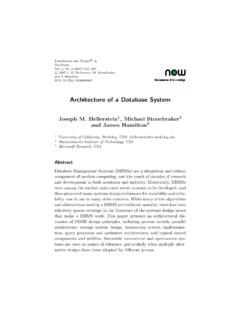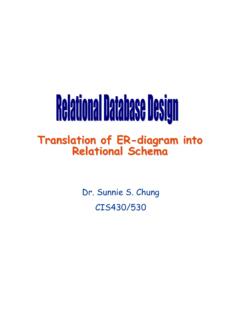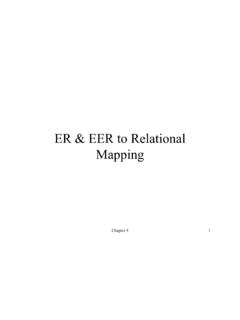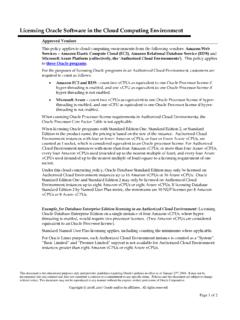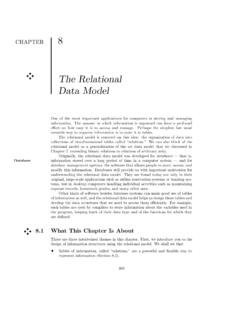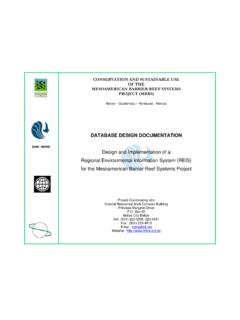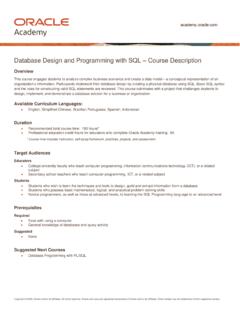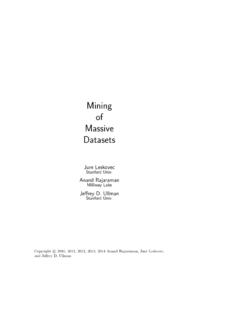Transcription of INTRODUCTION TO RDBMS
1 INTRODUCTION to RDBMS / 1 CHAPTER 1 INTRODUCTION TO RDBMS Objectives INTRODUCTION What is RDBMS ? Difference between DBMS & RDBMS Summary Check your Progress Answers Questions for Self Study Suggested Readings OBJECTIVES After reading this chapter you will be able to, Describe what RDBMS is State the difference between DBMS & RDBMS INTRODUCTION Most of the problems faced at the time of implementation of any system are outcome of a poor database design. In many cases it happens that system has to be continuously modified in multiple respects due to changing requirements of users. It is very important that a proper planning has to be done. A relation in a relational database is based on a relational schema, which consists of number of attributes.
2 A relational database is made up of a number of relations and corresponding relational database schema. The goal of a relational database design is to generate a set of relation schema that allows us to store information without unnecessary redundancy and also to retrieve information easily. One approach to design schemas that are in an appropriate normal form. The normal forms are used to ensure that various types of anomalies and inconsistencies are not introduced into the database . WHAT IS RDBMS ? RDBMS stands for relational database Management System. RDBMS data is structured in database tables, fields and records. Each RDBMS table consists of database table rows. Each database table row consists of one or more database table fields.
3 RDBMS store the data into collection of tables, which might be related by common fields ( database table columns). RDBMS also provide relational operators to manipulate the data stored into the database tables. Most RDBMS use SQL as database querylanguage. The most popular RDBMS are MS SQL Server, DB2, Oracle and MySQL. The relational model is an example of record-based model. Record based models are so named because the database is structured in fixed format records of several types. Each table contains records of a particular type. Each record type defines a fixed number of fields, or attributes. The columns of the table correspond to the attributes of the record types. The relational data model is the most widely used data model, and a vast majority of current database systems are based on the relational model.
4 The relational model was designed by the IBM research scientist and mathematician, Dr. Many modern DBMS do not conform to the Codd s definition of a RDBMS , but nonetheless they are still considered to be RDBMS . Two of s main focal points when designing the relational model were to further reduce data redundancy and to improve data integrity within database systems. Oracle / 2 The relational model originated from a paper authored by entitled A relational Model of Data for Large Shared Data Banks , written in 1970. This paper included the following concepts that apply to database management systems for relational databases. The relation is the only data structure used in the relational data model to represent both entities and relationships between them.
5 Rows of the relation are referred to as tuples of the relation and columns are its attributes. Each attribute of the column are drawn from the set of values known as domain. The domain of an attribute contains the set of values that the attribute may assume. From the historical perspective, the relational data model is relatively new .The first database systems were based on either network or hierarchical models .The relational data model has established itself as the primary data model for commercial data processing applications. Its success in this domain has led to its applications outside data processing in systems for computer aided design and other environments. DIFFERENCE BETWEEN DBMS & RDBMS A DBMS has to be persistent, that is it should be accessible when the program created the data ceases to exist or even the application that created the data restarted.
6 A DBMS also has to provide some uniform methods independent of a specific application for accessing the information that is stored. RDBMS is a relational Data Base Management System relational DBMS. This adds the additional condition that the system supports a tabular structure for the data, with enforced relationships between the tables. This excludes the databases that don't support a tabular structure or don't enforce relationships between tables. You can say DBMS does not impose any constraints or security with regard to data manipulation it is user or the programmer responsibility to ensure the ACID PROPERTY of the database whereas the RDBMS is more with this regard because RDBMS define the integrity constraint for the purpose of holding ACID PROPERTY.
7 , , and Check your progress Fill in the blanks 1) A relation in a relational database is based on a relational schema, which consists of number of .. 2) ..is a relational Data Base Management System. 3) Rows of the relation are referred to as .. of the relation 4) The relational model was designed by the IBM research scientist and mathematician, Dr.. 5) The .. is the only data structure used in the relational data model to represent both entities and relationships between them. State true or false 1) The normal forms never removes anomalies. 2) Each attribute of the column are drawn from the set of values known as domain. 3) The first database systems were based on either network or hierarchical models . 4) Most RDBMS use SQL as database query language. 5) relational database design makes data retrieval difficult.
8 SUMMARY The goal of a relational database design is to generate a set of relation schema that allows us to store information without unnecessary redundancy and also to retrieve information easily. A database system is an integrated collection of related files, along with details of interpretation of the data contained therein. DBMS is a s/w system that allows access to data contained in a database . The objective of the DBMS is to provide a convenient and effective method of defining, storing and retrieving the information contained in the database . INTRODUCTION to RDBMS / 3 The DBMS interfaces with application programs so that the data contained in the database can be used by multiple applications and users.
9 The DBMS allows these users to access and manipulate the data contained in the database in a convenient and effective manner. In addition the DBMS exerts centralized control of the database , prevents unauthorized users from accessing the data and ensures privacy of data. CHECK YOUR PROGRESS - ANSWERS , & Fill in the blanks 1) attributes 2) RDBMS 3) tuples 4) 5) relation True or false 1) False 2) True 3) True 4) True 5) False QUESTIONS FOR SELF - STUDY 1) Explain the following terms i) Domain ii) Tuple iii) Relation iv) Attribute 2) Explain difference between DBMS and RDBMS . 3) Why relational data model is so popular ? 4) What are record based models ? 5) How RDBMS stores its data ?
10 SUGGESTED READINGS Teach Yourself SQL in 21 Days - By Ryan K. Stephens Ronald R Plew Using Oracle Application - By Jim Crum Oracle / 4 NOTES Data Manipulation & Control / 5 CHAPTER 2 DATA MANIPULATION & CONTROL Objectives INTRODUCTION Subdivisions of SQL Data Definition Language Data Manipulation Language Commands Data Control Language Select Query and Clauses Select Statement with Order by Clause Group by Clause Having Clause String Operation Distinct Rows Rename Operation Set Operations Aggregate Functions Nested Sub Queries Embedded SQL Dynamic SQL Summary Check Your Progress - Answers Questions for Self Study Suggested Readings OBJECTIVES After reading this chapter you



